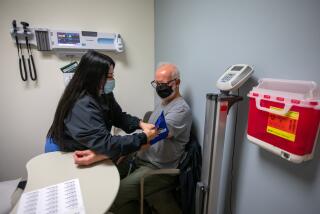Book Review : Horatio Alger Story Turned Upside Down, Inside Out
Appointment for Murder: The Story of the Killing Dentist by Susan Crain Bakos (G. P. Putnam’s Sons: $18.95, 286 pages)
What can you say about a man who seduced young women and then turned them into accomplices in murder; who killed with genuine pleasure but took offense at pornography; who detested blacks, Jews, cops and the IRS with equal passion; who hated lawyers but loved lawsuits; and who, to make things still worse, was a bad dentist?
Susan Crain Bakos has much to say about such a man in “Appointment for Murder,” the true story of a sorry but scary St. Louis dentist named Glennon Engleman (better known by his adoring cronies as “the Doc”), who masterminded a series of penny-ante insurance murders over more than two decades. Bakos tells the story with much gusto, making good use of court records and police transcripts to give us an all-too-intimate look at the Doc and his murderous minions. But even as I read the book with the kind of horrified fascination that one experiences at the scene of a messy accident, I kept asking myself: Is this book really necessary?
Preyed on the Unsophisticated
The Doc’s modus operandi was a bad imitation of “Double Indemnity.” He preyed on poor, young, unsophisticated, but ambitious women who were impressed with the fact that he was “a professional man.” (The women couldn’t have been very impressed with the Doc himself--he had a paunch and a foul mouth, owned one suit, drove an old car, and was an utter failure at the practice of dentistry.) The Doc painstakingly tutored each woman in the sexual practices that he preferred--”He kept up sex talk the way amateur ball players chatter in the field”--and then sent her out to use her new sexual skills to snare a husband. Finally, the Doc would blow up the well-insured husband, or shoot him, or hit him on the head with a hammer, with the well-trained wife waiting to clean up the mess and--again tutored by the Doc--play the role of bereaved widow until they split up the insurance proceeds.
Bakos writes of the Doc’s crimes in gruesome detail, but she seems to be even more interested in his sexual exploits, which she describes in precisely the same style as those steamy but anatomically explicit letters in Penthouse magazine. (In fact, she goes over the same sexual scenario again and again, until--as with the Penthouse letters--we feel that we could write it ourselves.)
Safely Behind Bars
Do we really need to know this--or anything else, for that matter--about Glennon Engleman, who is now safely behind bars where he belonged all along? The publisher has the chutzpah to compare the Doc and his crimes to “the tradition of Dostoevsky’s Raskolnikov” in the overheated press release that accompanied my review copy--but the Doc is so vile and yet so petty in his criminal and sexual aspirations that the comparison is ludicrous. And Bakos, although she tries hard and writes well, does not give “Appointment for Murder” the literary stature that we find in classics of “true crime” writing such as Truman Capote’s “In Cold Blood” or Ed Sanders’ “The Family.”
Indeed, if there is any enduring significance to “Appointment for Murder,” other than as a horrifyingly readable penny-dreadful, it is to be found in Bakos’ insight into how a young woman from a poor family--or an older woman from a broken marriage--might succumb to the otherwise laughable entreaties of a pathetic loser like the Doc, who flattered their sexual powers and promised them his dubious patronage. Indeed, “Appointment for Murder” is ultimately an Horatio Alger story turned upside down and inside out:
“If he’d been less than a professional man, lived elsewhere than the South Side of St. Louis, and surrounded himself with people who had more education, years and life experience than the young and poor he attracted like a magnet, he wouldn’t have been the demigod he was,” Bakos writes. “This man, whose self-conception was heroic, exhibited the same primitive emotions of any antisocial punk: spite, vanity, sentimental affections, and hot flashes of violent anger.”
More to Read
Sign up for our Book Club newsletter
Get the latest news, events and more from the Los Angeles Times Book Club, and help us get L.A. reading and talking.
You may occasionally receive promotional content from the Los Angeles Times.








